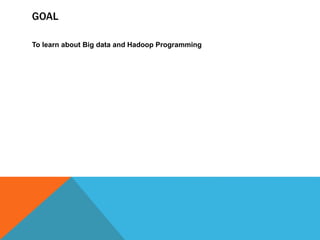INTRODUCTION TO BIG DATA HADOOP
- 2. GOAL To learn about Big data and Hadoop Programming
- 3. AGENDA Big Data Hadoop Introduction History Comparison to Relational Databases Hadoop Eco-System and Distributions Resources
- 4. BIG DATA Information Data Corporation (IDC) estimates data created in 2010 to be Companies continue to generate large amounts of data, here are some 2011 stats: – Facebook ~ 6 billion messages per day – EBay ~ 2 billion page views a day, ~ 9 Petabytes of storage – Satellite Images by Skybox Imaging ~ 1 Terabyte per day
- 5. HADOOP Existing tools were not designed to handle such large amounts of data "The Apache™ Hadoop™ project develops open-source software for reliable, scalable, distributed computing." - http://hadoop.apache.org – Process Big Data on clusters of commodity hardware – Vibrant open-source community – Many products and tools reside on top of Hadoop
- 6. HADOOP JOBS
- 8. DATA STORAGE Storage capacity has grown exponentially but read speed has not kept up – 1990: • Store 1,400 MB • Transfer speed of 4.5MB/s • Read the entire drive in ~ 5 minutes– 2010: • Store 1 TB • Transfer speed of 100MB/s • Read the entire drive in ~ 3 hours • Hadoop - 100 drives working at the same time can read 1TB of data in 2 minutes
- 9. HADOOP CLUSTER A set of "cheap" commodity hardware • Networked together • Resides in the same location – Set of servers in a set of racks in a data center
- 10. USE COMMODITY HARDWARE “Cheap” Commodity Server Hardware – No need for super-computers, use commodity unreliable hardware – Not desktops
- 11. HADOOP SYSTEM PRINCIPLES Scale-Out rather than Scale-Up Bring code to data rather than data to code Deal with failures – they are common Abstract complexity of distributed and concurrent applications
- 12. SCALE OUT INSTEAD OF SCALE UP It is harder and more expensive to scale-up – Add additional resources to an existing node (CPU, RAM) – Moore’s Law can’t keep up with data growth – New units must be purchased if required resources can not be added – Also known as scale vertically • Scale-Out – Add more nodes/machines to an existing distributed application – Software Layer is designed for node additions or removal – Hadoop takes this approach - A set of nodes are bonded together as a single distributed system – Very easy to scale down as well
- 13. CODE TO DATA • Traditional data processing architecture – nodes are broken up into separate processing and storage nodes connected by high-capacity link – Many data-intensive applications are not CPU demanding causing bottlenecks in network Storage Node Processing Node Processing Node Storage Node Load Data Save Results Risk of bottleneck
- 14. CODE TO DATA Hadoop co-locates processors and storage – Code is moved to data (size is tiny, usually in KBs) – Processors execute code and access underlying local storage 16 Processor Storage Hadoop Node Processor Storage Hadoop Node Processor Storage Hadoop Node Processor Storage Hadoop Node
- 15. FAILURES ARE COMMON Given a large number machines, failures are common – Large warehouses may see machine failures weekly or even daily • Hadoop is designed to cope with node failures – Data is replicated – Tasks are retried
- 16. ABSTRACT COMPLEXITIES Hadoop abstracts many complexities in distributed and concurrent applications – Defines small number of components – Provides simple and well defined interfaces of interactions between these components • Frees developer from worrying about systemlevel challenges – race conditions, data starvation – processing pipelines, data partitioning, code distribution – etc. • Allows developers to focus on application development and business logi
- 17. HISTORY OF HADOOP Started as a sub-project of Apache Nutch – Nutch’s job is to index the web and expose it for searching – Open Source alternative to Google – Started by Doug Cutting • In 2004 Google publishes Google File System (GFS) and MapReduce framework papers • Doug Cutting and Nutch team implemented Google’s frameworks in Nutch • In 2006 Yahoo! hires Doug Cutting to work on Hadoop with a dedicated team • In 2008 Hadoop became Apache Top Level Project – http://hadoop.apache.org
- 18. NAMING CONVENTIONS Doug Cutting drew inspiration from his family – Lucene: Doug’s wife’s middle name – Nutch: A word for "meal" that his son used as a toddler – Hadoop: Yellow stuffed elephant named by his son
- 19. COMPARISON TO RDBMS Until recently many applications utilized Relational Database Management Systems (RDBMS) for batch processing – Oracle, Sybase, MySQL, Microsoft SQL Server, etc. – Hadoop doesn’t fully replace relational products; many architectures would benefit from both Hadoop and a Relational product(s) • Scale-Out vs. Scale-Up – RDBMS products scale up • Expensive to scale for larger installations • Hits a ceiling when storage reaches 100s of terabytes – Hadoop clusters can scale-out to 100s of machines and to petabytes of storage
- 20. COMPARISON TO RDBMS Structured Relational vs. Semi-Structured vs. Unstructured – RDBMS works well for structured data - tables that conform to a predefined schema – Hadoop works best on Semi-structured and Unstructured data • Semi-structured may have a schema that is loosely followed • Unstructured data has no structure whatsoever and is usually just blocks of text (or for example images) • At processing time types for key and values are chosen by the implementer – Certain types of input data will not easily fit into Relational Schema such as images, JSON, XML, etc...
- 21. END Thank you.





















